As Crowds Grow, State Parks Plan to Add Day-Pass Reservations
By Carlos Anchondo
Photography By Andrea Garcia
Reporting Texas
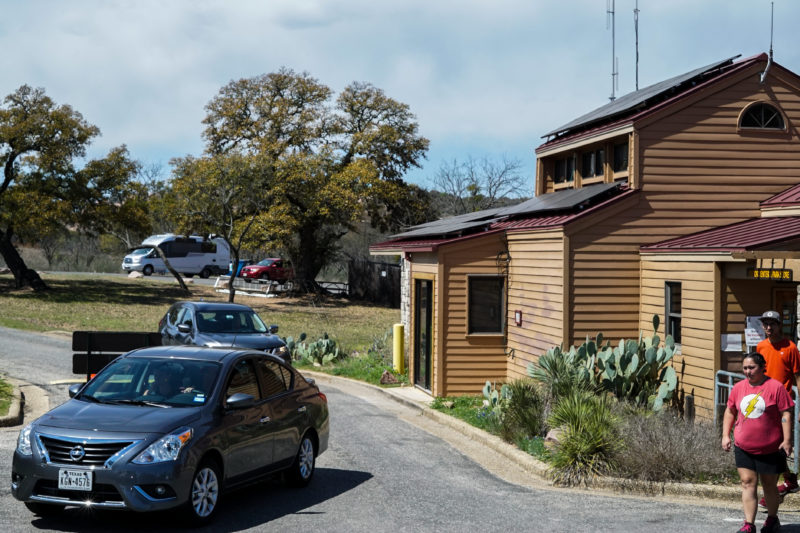
Cars line up at the entrance of Enchanted Rock, where visitors can explore nearly nine miles of trails. Andrea Garcia/Reporting Texas
It is 8 a.m., and already a long line of cars has formed along Ranch Road 965 just outside of Enchanted Rock State Natural Area. Drivers steer onto the gravel shoulder or adjacent grassy slope in an effort to avoid blocking traffic on the two-lane highway. Cars approaching from Fredericksburg, 18 miles south, drive past the entrance gate and make haphazard U-turns to take their place in the queue.
The lure is trekking up the park’s iconic, 1,825 foot-high pink granite dome, which offers a panoramic view of the hiking trails and other natural spots in the park. Enchanted Rock appears regularly on Top 10 lists for hiking, camping and places to see in the Hill Country.
The 277-space parking lot fills by 9, and park rangers activate a flashing sign to indicate it is closed for now. They hand out vouchers to cars in line that will let them in at 1 p.m. The crowds are largest in the spring and summer, meaning even more people can’t get in.
The park is one of many Texas state parks, natural areas and historic sites hitting capacity every weekend and some weekdays. Over the past six years, visitation at the 99 Texas state parks, natural areas and historic sites has increased by more than 20 percent, with 9.7 million visitors in fiscal year 2017.
In December, Texas Parks & Wildlife (TPWD) will introduce a reservation system allowing visitors to purchase a day pass or advance permit up to a month ahead of time, reducing the number of frustrated visitors who drive sometimes dozens of miles to enjoy hiking, rock-climbing and other outdoor activities, only to find the park is out of room.
“We want people to have some assurance in advance about whether or not they are going to get into a park that day,” said Brent Leisure, director of Texas state parks. “This will minimize the amount of people who show up and cannot be accommodated. There is a tremendous advantage to be able to buy that day pass in advance.”
Park users already can reserve rentable facilities, such as campsites or cabins, but not day-use permits.
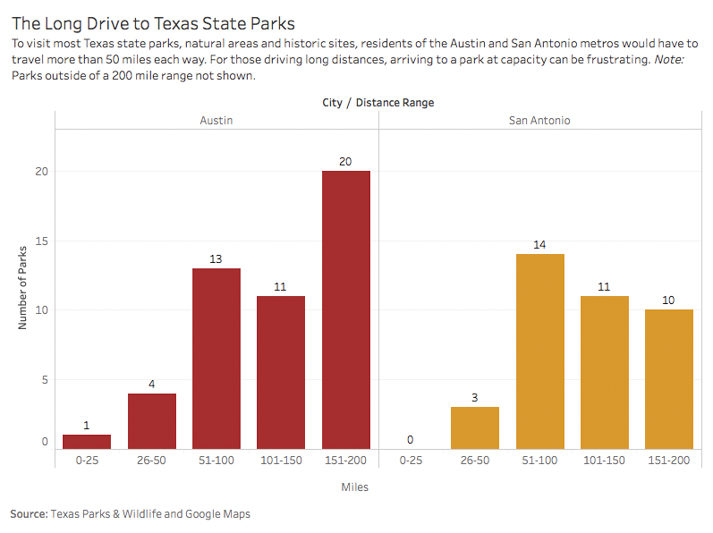
Texas’ growing population, particularly along the Interstate 35 corridor between San Antonio and Austin, is putting more pressure on the parks. Travis County’s population has increased by 50 percent since 2000, to 1.2 million people. Bexar County was up 41 percent, to nearly 2 million people. Some smaller surrounding counties have doubled in size.
“A lot of our Central Texas parks have been reaching their visitation capacity almost weekly,” said Stephanie Garcia, a TPWD spokeswoman. “We want everyone to have a great experience at our parks, but, if there is too much traffic, it can really impact not only the visitor experience, but also the resource itself.”
Reaching capacity means more than a full parking lot, Capacity includes demands on facilities, such as restrooms, roads, and trails, as well as demands on park staff.
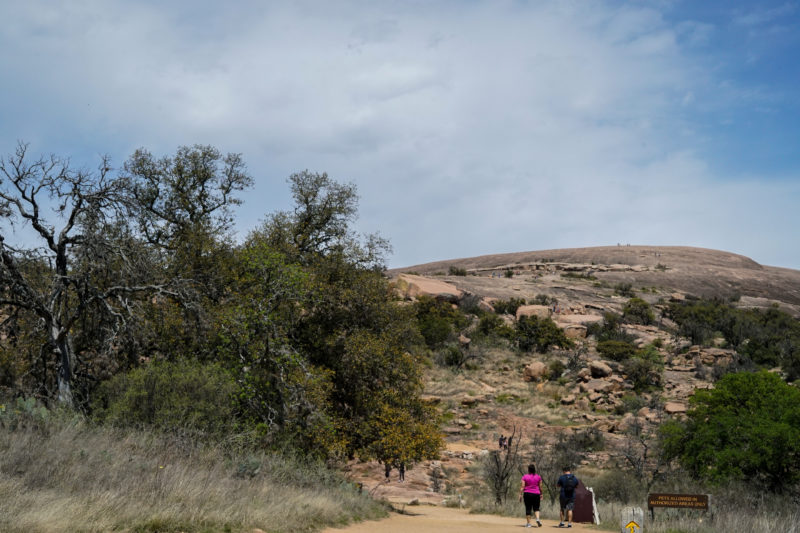
Visible for miles, Enchanted Rock attracts large crowds eager to hike its weathered granite dome. A trail from the parking lot leads to the dome’s peak. Andrea Garcia/Reporting Texas
Texas has only two national parks – Big Bend National Park and Guadalupe Mountains National Park in far West Texas – meaning people depend mostly on state and local parks for outdoor recreation. In Texas, many park goers are being forced to become strategic to plan camping trips, rock-climbing expeditions or a simple day hike.
Teresa Isensee, 27, works in technology in Austin and regularly spends her weekends camping and hiking. A couple weekends ago, Isensee and friends drove the 100 miles to Enchanted Rock, only to encounter the flashing park-closed sign. They eventually were lucky enough to get in.
They didn’t even try to get a campsite there, and found a site on nearby private land.
“We didn’t even try, because whenever I try to book a campsite at any of the state parks, I can never get in,” Isensee said. “I would love to camp at state parks, but it is extremely difficult to find a site.”
The state parks website allows users to search up to five parks simultaneously for available reservations. However, camping sites frequently are booked weeks and even months in advance, especially in peak seasons such as spring break or summer vacation.
Meredith Kinsey, an Austin-based real estate agent, said her family of four typically books camp sites four to six months in advance. Their favorites include Colorado Bend and Inks Lake, parks northwest of Austin. Sometimes, she said, it’s easier to look for private camping sites.
“Like everything, it’s getting a little bit more complicated with the growth,” Kinsey said. “It is not going to keep us from camping, but it may direct our attention away from the state parks, because we just need more options.”
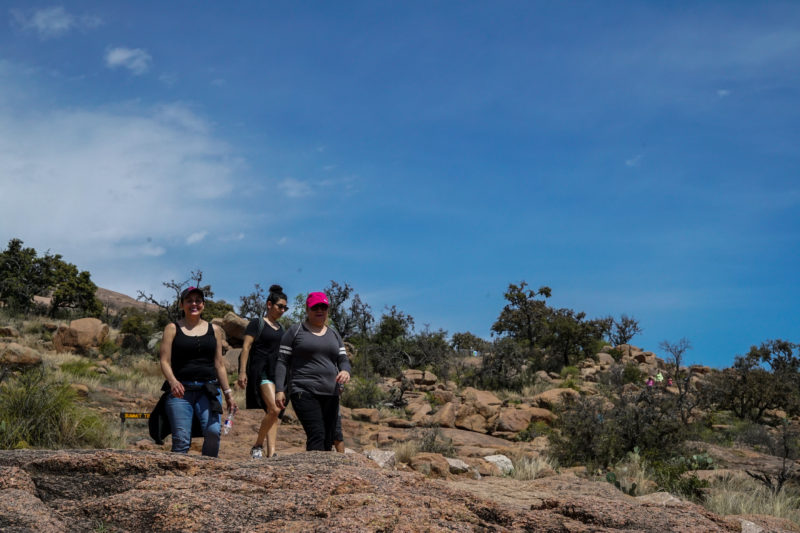
Park visitors, Gabriela Holguin and Bianca Piña, come down from Enchanted Rock’s peak, which offers expansive views of the surrounding Hill Country.
Andrea Garcia/Reporting Texas
She said she sees how a day-pass would help at top-draw parks such as Enchanted Rock, which she dubs “the Disneyland” of Texas state parks. But it’s no longer possible to put the kids in the car on a nice day and simply head out for a state park.
Nevertheless, officials such as Tommy Cude, superintendent of McKinney Falls State Park in Austin, are excited about the new system and its day-pass feature. McKinney Falls, 10 miles southeast of downtown, had nearly 320,000 visitors in 2017, a 104 percent increase since 2012. Bisected by Onion Creek, the park is known for its limestone rock ledges and incandescent natural pools.
“That component will be a really great thing,” Cude said. “People don’t want to come here and feel like they’re at a mall, shoulder-to-shoulder with somebody. They are coming for an experience in nature.”
As they strive to remain good stewards of the natural resource and to provide access, park managers are struggling to keep up with the pressure of more visitors. State parks need between $50 million and $80 million for maintenance and infrastructure repair during each two-year state budget cycle, according to Leisure. State parks have an estimated deferred maintenance backlog of $700 million.
JJ Fleury, a planner with Texas State Parks’ planning and geospatial resources office, is part of a team conducting a capacity study. A pilot program at Guadalupe River State Park, in Spring Branch, will help the department better understand the effects of increased urbanization around parks, the visitor experience, and demands on facilities and natural resources, as well as staffing.
“The idea is to learn from Guadalupe State Park and then take that to a series of meetings with the public and certain stakeholders,” Fleury said. “One of the reasons we chose Guadalupe is because it is right at capacity. We know it’s going to be there soon, but it isn’t quite there.”
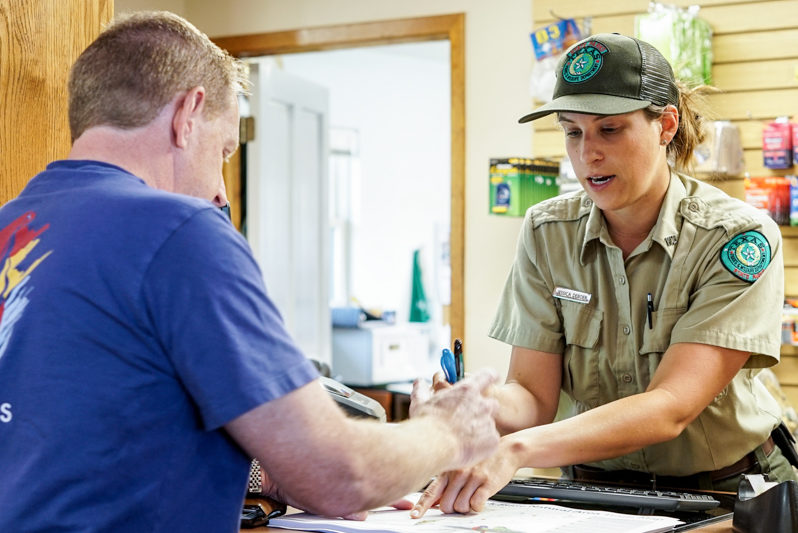
Enchanted Rock staff member, Jessica DeBuer, registers a new park member on March 18, 2018. Andrea Garcia/Reporting Texas
The team will travel to all six TPWD regions to involve the public and local stakeholders.
At Enchanted Rock, the voucher system was introduced after record visitation led to miles-long car lines along 965. Doug Cochran, park superintendent, was concerned about driver safety.
“We are always looking at our operations to increase safety, but we’re limited by the amount of personnel that we have,” Cochran said. “At the end of our fiscal year in 2016, we had 344,960 visitors. I recommended to our regional director, I said, ‘We can’t sustain this type of visitation. We can’t sustain that from several resource aspects – our natural resource, our infrastructure, our human resource, our staff.’ Our facilities were failing.”
He hopes day-pass reservations will ease the strain.
“With this system, people are not going to have a two-hour wait in line or anything like that,” Cochran said. “You can go online, purchase that ticket and, barring a natural catastrophe, you will know that you are going to get into that day.”